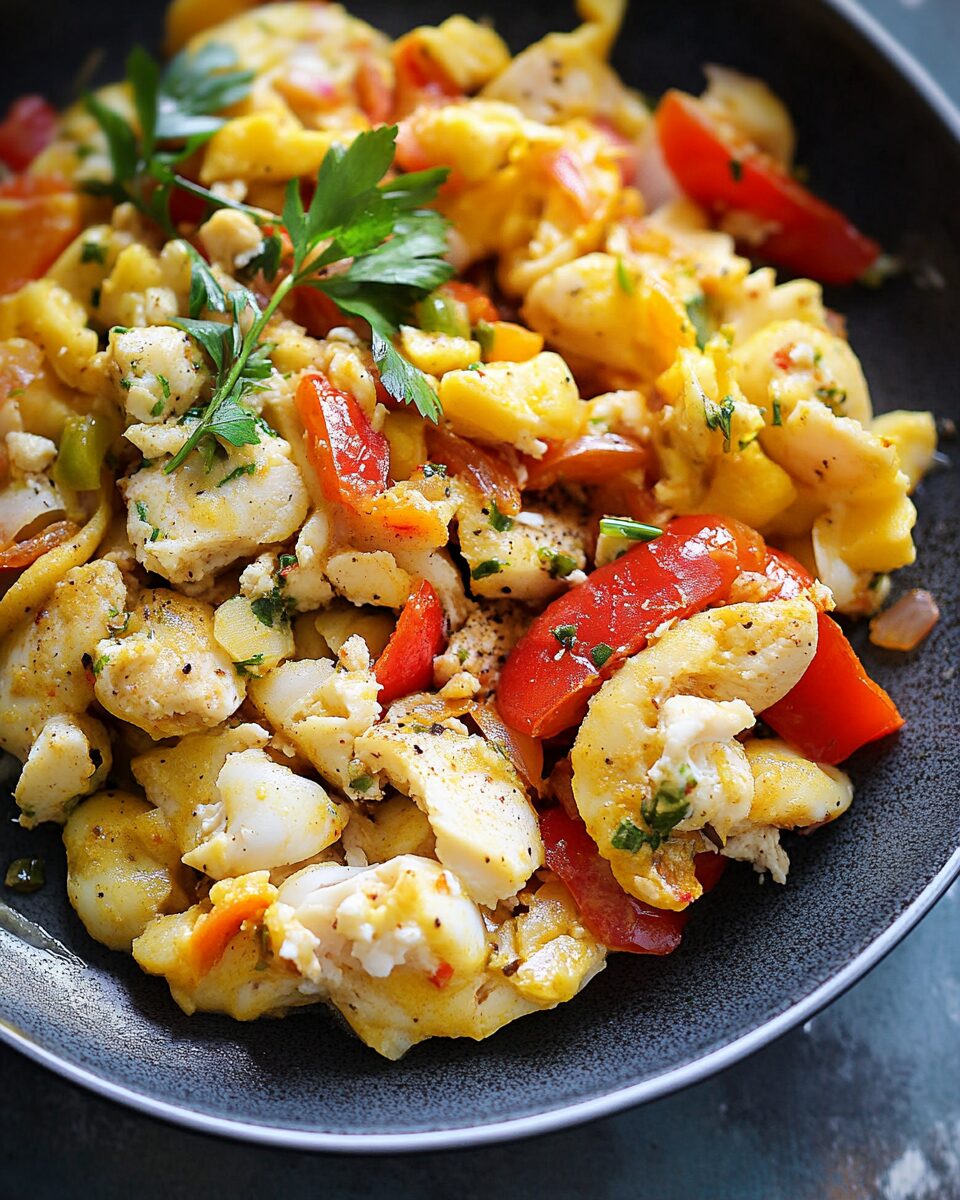Ackee and Saltfish is the national dish of Jamaica, cherished for its unique blend of flavors and cultural significance. This traditional breakfast combines the creamy texture of ackee fruit with the savory taste of salted codfish, sautéed alongside aromatic vegetables and spices.
FULL RECIPE:
Ingredients
- 1 can (540 ml) of ackee, drained and rinsed
- 1/2 lb salted codfish (saltfish)
- 1 medium onion, sliced
- 1 medium tomato, diced
- 1/2 red bell pepper, sliced
- 1/2 green bell pepper, sliced
- 2 sprigs fresh thyme
- 1 scotch bonnet pepper, finely chopped (optional)
- 2 cloves garlic, minced
- 2 tbsp vegetable oil
- Black pepper, to taste
Directions
- Prepare the Saltfish: Soak the salted codfish in water for at least 2 hours or overnight to remove excess salt. Change the water a few times during soaking. After soaking, place the fish in a pot of fresh water, bring to a boil, and simmer for about 15 minutes. Drain, let it cool, then flake into small pieces, removing any bones and skin.
- Sauté Vegetables: In a large skillet, heat vegetable oil over medium heat. Add sliced onions, bell peppers, tomatoes, garlic, thyme, and scotch bonnet pepper (if using). Sauté until the vegetables are tender and aromatic, about 5 minutes.
- Add Saltfish: Add the flaked saltfish to the skillet with the sautéed vegetables. Stir well and cook for an additional 2 minutes to allow the flavors to meld.
- Incorporate Ackee: Gently fold the drained ackee into the skillet, being careful not to overmix to prevent the ackee from breaking apart. Cook until the ackee is heated through, about 3-5 minutes. Season with black pepper to taste.
- Serve: Remove from heat and serve hot. Traditionally, ackee and saltfish is accompanied by fried dumplings, boiled green bananas, or roasted breadfruit.
Nutrition Facts
- Calories: 353 kcal
- Protein: 24 g
- Fat: 18 g
- Carbohydrates: 24 g
The Cultural Significance of Ackee and Saltfish
Ackee and Saltfish is not only a culinary delight but also a symbol of Jamaican heritage and pride. It represents the island’s resilience and creativity in turning humble ingredients into a celebrated national dish. Ackee, native to West Africa, made its way to Jamaica through the transatlantic slave trade and has since become an essential part of the country’s cultural fabric. Paired with saltfish, which was a staple preserved food for enslaved Africans, the dish carries a historical significance that resonates deeply with Jamaicans.
Flavor Profile and Texture
The beauty of Ackee and Saltfish lies in its harmonious balance of flavors and textures. The ackee fruit has a creamy, buttery texture with a mild, nutty taste, which complements the briny saltfish. The addition of onions, bell peppers, tomatoes, and aromatic spices enhances the dish, creating a vibrant and flavorful experience. The scotch bonnet pepper adds a touch of heat, while the thyme and garlic bring earthy notes, making each bite both comforting and bold.
Health Benefits
This traditional meal offers several nutritional benefits. Ackee is rich in healthy fats, particularly monounsaturated and polyunsaturated fats that promote heart health. It also provides essential vitamins like Vitamin A, which supports vision and immune function, and Vitamin C, which acts as a powerful antioxidant. Saltfish, on the other hand, is an excellent source of protein and omega-3 fatty acids, which are beneficial for brain and heart health. However, due to its high sodium content, it’s essential to properly soak and boil the saltfish to reduce its salt levels.
Traditional Serving Options
In Jamaica, Ackee and Saltfish is often served as a breakfast dish, accompanied by boiled green bananas, fried dumplings (known as festival or Johnny cakes), and fried plantains. The starchy sides provide a satisfying contrast to the creamy ackee and savory saltfish. For a lighter option, it can also be paired with steamed callaloo or breadfruit. Some variations may include the addition of black pepper for extra spice or fresh scallions for a pop of color and freshness.
Variations and Adaptations
While the traditional preparation remains the most beloved, many adaptations exist to suit different dietary needs and preferences. Some versions substitute the saltfish with smoked herring or mackerel for a distinct flavor. For a vegetarian twist, some cooks omit the saltfish altogether, focusing solely on the ackee and vegetables. Health-conscious individuals may opt for a low-sodium version by carefully rinsing the saltfish multiple times.
Cooking Tips and Techniques
To achieve the best results, it’s crucial to handle ackee with care, as it is a delicate fruit that can break apart easily. When sautéing the vegetables, ensure they are cooked until just tender to retain their vibrant colors and freshness. The saltfish should be well-flaked and evenly distributed throughout the dish to ensure each bite is flavorful. Adding a dash of lime juice can brighten the dish and enhance the flavors.
Cultural Celebrations and Traditions
Ackee and Saltfish is often featured during Jamaican cultural celebrations, family gatherings, and festive holidays. It is a staple at Sunday brunch tables and is frequently served during events like Independence Day celebrations. The dish is a point of pride and is often showcased in international food festivals, representing the rich culinary heritage of Jamaica.
Pairing with Beverages
Ackee and Saltfish pairs wonderfully with traditional Jamaican beverages. A glass of freshly squeezed fruit juice, such as pineapple, mango, or guava, complements the dish’s savory elements. Additionally, a steaming cup of Blue Mountain coffee or a refreshing ginger beer can enhance the overall dining experience.
Culinary Tourism in Jamaica
For those visiting Jamaica, enjoying authentic Ackee and Saltfish is a must. Many local restaurants and street vendors serve the dish, offering travelers a genuine taste of Jamaican hospitality. Culinary tours often include cooking demonstrations, providing visitors with the opportunity to learn the preparation techniques firsthand and appreciate the cultural significance of the dish.
Advertisement
Conclusion
Ackee and Saltfish stands as a testament to Jamaica’s culinary ingenuity and cultural resilience. Its vibrant flavors and rich history make it a cherished dish not only in Jamaica but also across the globe. Whether enjoyed as a hearty breakfast or as part of a festive meal, this national dish offers a true taste of the island’s spirit. Embracing the tradition of preparing and sharing Ackee and Saltfish allows individuals to connect with Jamaican culture and celebrate its enduring legacy. For anyone seeking a delicious, authentic, and culturally significant meal, Ackee and Saltfish is an excellent choice.






